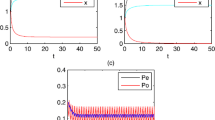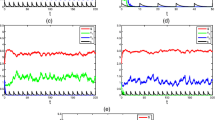In this paper, the dynamic behaviors of a Monod type chemostat model with impulsive perturbation are investigated. Using Floquet theory and small amplitude perturbation method, we prove that the microorganism-eradication periodic solution is asymptotically stable if the impulsive period satisfies some conditions. Moreover, the permanence of the system is discussed in detail. Finally, we verify the main results by numerical simulation.
Similar content being viewed by others
References
Simth H.L., Waltman P., (1995). The Theory of the Chemostat. Cambridge University Press, Cambridge
L.S. Chen and J. Chen, Nonlinear Biological Dynamic Systems (Science Press, Beijing, 1993) (Chinese).
Hsu S.B., Hubbell S.P., Waltman P., (1977) A mathematical theory for single nutrient competition in continuous cultures of micro-organisms. SIAM J. Appl. Math. 32: 366–383
Hale J.K., Somolinas A.S., (1983) Competition for fluctuating nutrient. J. Math. Biol. 18: 255–280
Buler G.J., Hsu S.B., Waltman P., (1985) A mathematical model of the chemostat with periodic washout rate. SIAM J. Appl. Math. 45: 435–449
Wolkowicz G.S.K., Zhao X.Q., (1998) N-spicies competition in a periodic chemostat. Diff. Integr. Eq. 11: 465–491
Lakshmikantham V., Bainov D.D., Simeonov P.S., (1989). Theory of Impulsive Differential Equations. World Scientific, Singapore
Bainov D.D., Simeonov P.S., (1993). Impulsive Differential Eqations: Periodic Solutions and Applications. Longman Scientific and Technical, Burnt Mill
Liu X.N., Chen L.S., (2003) Complex dynamics of Holling type II Lotka-Volterra predator-prey system with impulsive perturbations on the predator. Chaos Soliton. Fract. 16: 311–320
Roberts M.G., Kao R.R., (1998) The dynamics of an infectious disease in a population with birth pulses. Math. Biosci. 149: 23–36
Ballinger G., Liu X., (1997) Permanence of population growth models with impulsive effects. Math. Comput. Modell. 26: 59–72
Liu X., Rohlf K., (1998) Impulsive control of a Lotka–Voterra system. IMA J. Math. Control Inform. 15: 269–284
Funasaki E., Kot M, (1993) Invasion and chaos in a periodically pulsed mass-action chemostat. Theor. Popul. Biol. 44: 203–224
Smith R.J., Wolkowicz G.S.K., (2004) Analysis of a model of the nutrient driven self-cycling fermentation process, Dyn. Contin. Discrete Impul. Syst. Ser. B, 11: 239–265
Author information
Authors and Affiliations
Corresponding author
Rights and permissions
About this article
Cite this article
Sun, S., Chen, L. Dynamic behaviors of Monod type chemostat model with impulsive perturbation on the nutrient concentration. J Math Chem 42, 837–847 (2007). https://doi.org/10.1007/s10910-006-9144-3
Received:
Revised:
Published:
Issue Date:
DOI: https://doi.org/10.1007/s10910-006-9144-3




